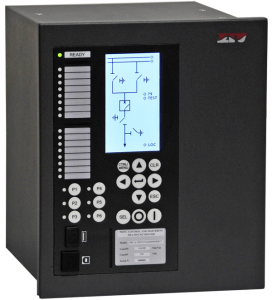AVR – Automatic voltage regulation for up to 5 power transformers in parallel.
Parallel transformer regulation by master-slave, circulating current and negative reactance methods.
It also includes line voltage drop compensation.
AVR Key Features
- Voltage Regulation. Maintains the transformer output voltage at the setpoint value, calculating the difference between the measured voltage and the setpoint voltage and comparing it with a threshold level to decide whether to send commands to the tap changer. The first tap change command has a time delay based on an inverse curve or a fixed time. Subsequent commands always have a fixed time delay.
- Line Voltage Drop Compensation. A compensation based on the measured current and the voltage drop between the transformer and the load, that provides stable voltage under load. The compensation can be calculated by two methods: LDC-Z or LDC-R & X.
- Parallel Transformers Regulation. Parallel transformer regulation can be achieved by the following methods:
- Master / slave
- Circulating current
- Negative reactance
The first two methods in the list allow voltage regulation for up to 5 parallel transformers using GOOSE messaging (IEC 61850 ed 1 and 2).
- Tap Indication and Monitoring.The active tap can be read by digital inputs (directly or in BCD code), by an analog current transducer or by a Resistor Chain. Tap monitoring permits to generate alarms corresponding to irregular or extreme tap positions and to failures after tap change commands.
General characteristics of the “ZIV e-NET flex family” protection relays:
- Powerful programable logic. 9 2000 event log. Up to 100 oscillography seconds.
- Alphanumeric or graphic display.
- 160 DI, 80 DO, and 22 LEDs.
- Bonding, RSTP, PRP and HSR Redundancy.
- IEC 61850 Ed.2, DNP3.0, Modbus RTU and PROCOME Protocols.
- Native process bus. Analog input cards operate as Merging Units for the CPU. Synchronized samples at 4800 Hz (as per IEC 61869-9).
- Cybersecurity in accordance with IEC 62351, IEC 62443 and IEEE 1686-2013 standards. RBAC, secure keys, physical and logical port disabling, cybersecurity event log, securing of management protocols (PROCOME, HTTPS, SFTP, SSH), remote authentication (LDAP, RADIUS) and digital firmware securitization.
- Time synchronization by IRIG-B, SNTP and PTP (Ordinary Clock / Transparent Clock).
Literature
- Instructions Manual: M0RTFA1902Iv30 (02 / 16 / 2024)
- Data Sheet: H0RTFA1807Iv02 (EN) F0RTFA1809Fv00 (FR) F0RTFA2304Pv00 (PT)


